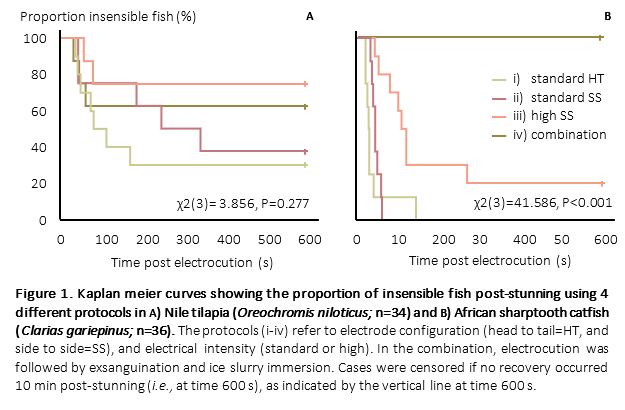STUNNING NEWS: EFFECTS OF IN-WATER ELECTRICAL EXPOSURE ON BRAIN FUNCTION IN NILE TILAPIA Oreochromis niloticus AND AFRICAN SHARPTOOTH CATFISH Clarias gariepinus
Background
Nile tilapia (Oreochromis niloticus) and African sharptooth catfish (Clarias gariepinus) are two important aquaculture species whose global production have increased significantly over the last decades (FAO, 2022). Ensuring a humane end of life for these species is essential for a number of interconnected reasons, spanning ethical, legal, scientific, and societal considerations . Common slaughter methods for these fish , such as asphyxiation, gill cutting, decapitation and/or evisceration , fail to meet the standards of humane slaughter, which require the use of an effective stunning method prior to killing ( EFSA, 2004; Lines and Spence , 2011; Robb and Kestin , 2002; WOAH, 2019). E lectrical stunning has been proposed as a more humane alternative (WOAH, 2019) and species-specific laboratory studies have demonstrated that if enough electrical energy is delivered it can induce a loss of sensibility for at least one minute in both tilapia and catfish. Further, when combined with throat cutting and immersion in ice slurry, no signs of recovery were observed for either species during a 30 min post- stunning period (Brijs et al., 2021; Sundell et al., 2024). While the se findings highlight a poten tial of electrical stunning, the effectiveness and feasibility at scale warrants further validation under commercial conditions . Therefore, we designed a study to assess the effectiveness of in-water electrical stunning of these commercially important species at the farm level .
Material and methods
In-water electrical stunning was tested on tilapia and catfish at a commercial RAS farm in Skåne, Sweden, using a custom-built electrical stunner (Ace Aquatec Ltd., UK; AC source , 50 Hz). Fish were captured and subjected to an electrical stunning protocol under controlled conditions (785 ± 5 µS cm⁻¹, 21 ± 0.3 °C), after which they were instrumented with electroencephalography (EEG) electrodes to measure brain activity for 10 min. Stunning effectiveness was assessed via the presence or absence of visually evoked responses (VERs) in the EEG. Four stunning protocols, with regards to electrode configuration and electric intensity, were tested: (i) head-to-tail (HT) standard intensity , (ii) side-to-side (SS) standard intensity , (iii ) SS high intensity , and (iv ) SS high intensity combined with exsangui nation and ice slurry immersion. The stun duration was 40 s for catfish a nd 30 s for tilapia . Low intensity was 11.63 ± 0.05 V cm-1 (0.979 ± 0.025 A dm-2 ) and 10.10 ± 0.04 V cm-1 (0.870 ± 0.029 A dm-2 ) for catfish and tilapia, respectively, while high intensity was 17.48 ± 0.04 V cm-1 (1.696 ± 0.038 A dm-2 ) and 13.52 ± 0.04 V cm-1 (1.135 ± 0.014 A dm-2 ) for catfish and tilapia, respectively.
Results
A Kaplan meier analysis of time until recovery of sensibility post- stunning revealed no significant differences between treatment groups for tilapia (χ2(3)=3.856, P=0.277 ) but a significant effect for catfish (χ2(3)=41.586, P=<0.001; Figure 1). In catfish, 100 % insensibility was achieved in the combinational group (iv ) while all other treatments (i.e., groups i-iii) reached only 0-20 % (Figure 1). With the high intensity SS stunning, 25 % of tilapia recovered VERs within 54-77 s, and 80 % of catfish within 43-269 s. Duration of VERs differed significantly between groups for both species (tilapia: χ²(3)=8.657, P =0.034; catfish : χ²(3)=31.119, P <0.001). In tilapia, the combinational group (iv) differed significantly from both HT (i ; P=0.007) and SS low intensity ( ii; P =0.042). In catfish, the combinational g roup (iv ) differed from all other treatments (i -iii; P<0.001), and SS high intensity (iii) had shorter VER duration than SS low intensity ( ii; χ²( 3)=5.145, P=0.023).
Conclusion
In contrast to the results of our recent laboratory studies, the combination of electrical exposure, exsanguination and ice slurry immersion failed to prevent recovery in tilapia . While the same procedure achieved 100% insensibility in catfish , the rapid return of VERs , in some cases as early as within 43 s post-stunning , show that both throat cutting and immersion in ice slurry must occur immediately after stunning to prevent recovery during exsanguination and chilling. U ntil a clearly defined and practically feasible stun-to- stick interval can be established , the in-water electrical stunning as tested here cannot be recommended for either Nile tilapia or African sharptooth catfish . These findings highlight the need to refine stunning protocols under commercial conditions using species-specific parameters and precise timing to ensure humane slaughter of warm-water fish.
References
Brijs, J., Sundell, E., Hjelmstedt, P., Berg, C., Sencic , I., Sandblom, E., Gräans , A., 2021. Humane slaughter of African sharptooth catfish (Clarias gariepinus ): effects of various stunning methods on brain function. Aquaculture. 531: 735887.
EFSA. 2004. Opinion of the scientific panel on animal health and welfare on a request from the commission related to welfare aspects of the main systems of stunning and killing the main commercial species of animals. EFSA J . 45.
FAO, 2022. The State of World Fisheries and Aquaculture 2022. Towards Blue Transformation. FAO, Rome.
Lines J A and Spence J. 2011. Safeguarding the welfare of farmed fish at harvest. Fish Physiol Biochem. 38: 153–162.
Robb D H F and Kestin S C. 2002. Methods used to kill fish: Field observations and literature reviewed . Animal Welfare. 11: 269–282.
Sundell, E., Brijs, J. & Gräns, A. The quest for a humane protocol for stunning and killing Nile tilapia (Oreochromis niloticus ). Aquaculture. 593: 741317
WOAH (World Organisation of Animal Health). 2019. Welfare aspects of stunning and killing of farmed fish for human consumption. OIE Aquatic Animal Health Code, Chapter 7.3, 1-4.

